1:5 Scale Lysander Mk III. 161 (SD) Sqn. RAF
Discussion
OK, so after the very positive responses (thank you!) and the requests for further info in the 'Show us you Models' thread, I thought I would put a bit of a background and build story together for you.
Why a Lysander?
Well, I like unusual models. I find that people tend to gravitate towards the same models and so club flying days seem to be populated by lots of the same aircraft types; Spitfires and F-16’s being particular favourites it would seem. That being said, there are now 3 of these Lysanders owned/flown by members of my club! Anyway, there were none when I ordered the kit and that was part of my decision. Also, I like to model aircraft that have some sort of relevance. I live just a couple of miles from The Shuttleworth Collection at Old Warden, which amongst its aircraft is a Lysander that has for many years flown in the guise of an all-black Lysander of 161 (Special Duties) Squadron. That unit was itself based locally in period. What was RAF Tempsford, some 6 miles or so to the north.
By way of a quick outline of the aircraft’s history; the Lysander was conceived in the 1930’s as an Army Co-operation aircraft, mainly to act as an artillery spotting platform. To that end it was designed to land in small, un-prepared fields, close to the artillery guns so that written messages could quickly be handed over. However, this concept had been drawn up on the basis that the next war would be fought similarly to the entrenched scenarios witnessed in WW1. During the Battle of France it was quickly realised that technology had moved on a pace and that the Lysander in that role was now obsolete. But it’s short field landing and take off ability, and the space to carry passengers in the rear cockpit (previously a rear gunner/spotter provision) made it ideal for the Special Operations Executive (SOE) to use to send and retrieve agents from occupied France. Adopted by 161 (SD) Sqn, painted black, and operating on full moon nights, they became known as ‘Tempsford Taxis’.
I am by no means the first person to finish one of these models in 161 Sqn markings. One of the other models in my club was converted by it’s previous owner. Those that are often adopt the identity worn by the Shuttleworth aircraft; MA-B and indeed the club stablemate is just that. Mine will wear MA-E, an aircraft which was regularly flown by F/O James Atteby ‘Jim’ McCairns, a pilot with a quite remarkable history.
He joined the RAF as a Sergeant Pilot, and was posted to 616 Sqn flying Spitfires under the command of Douglas Bader. On one sortie he crash landed on a beach near Dunkirk, and was taken as a prisoner of war. Having escaped from Germany, he was picked up by the Belgian resistance who harboured him from the Nazis. He managed to be repatriated to the UK, but only after travelling across occupied western Europe to Gibraltar! Upon returning to the UK he was promoted to Flight Sergeant, and embarked on a tour of RAF stations delivering lectures on how to survive behind enemy lines and escape tactics. He then joined 161 (SD) Sqn. Where he was Commissioned as an Officer. He flew 34 Lysander missions, of which 25 were successful, making him the most effective Lysander SOE pilot. He was promoted to Flight Lieutenant and after a short stint as a Staff Officer he returned to flying Spitfires, Tempests, and Mosquitos. Unfortunately while on a low level training sortie in the latter he suffered an engine failure. The aircraft stalled a wing, rolled over and crashed in flames near RAF Finningley, killing Jim. He was 28.
A truly remarkable young man. A more in-depth account of his life can be found here:
https://en.wikipedia.org/wiki/Jim_McCairns
The Model
I used an Almost Ready To Fly (ARTF) kit made by a company called Seagull as the starting point. This is a type of model that is referred to as ‘Sports Scale’, meaning that it is representative of the real thing, but not a true scale model. Its wingspan is 117” which equates to about 3 meters and is designed to be powered by a 50 to 60cc petrol engine, or electric equivalent. Part of my gripe with RC models is that they often don’t sound right (turbine powered jets excepted). I often see beautifully detailed large scale Spitfires that look wonderful, but they’re hauled around the sky by single cylinder 2-strokers. It somewhat spoils the illusion. There are though some very sweet 4-stroke engines available, and in particular the radials do sound good, especially at idle. This was another driver for choosing this model as it pairs up nicely with the Saito 60cc 3 cylinder 4-Stroke radial. In fact it shouldn’t even require full throttle to potter around at something like scale speed.
Out of the box the model is quite crude. The pre-installed covering is smooth, plasticky, and somewhat shiny, not to mention inaccurate in colour for the aircraft that it represents (ironically another locally based airworthy Lizzie at Duxford). The pilot supplied is too big and wearing a red baseball cap (Trump?). The representation of the cockpit dashboard had what looked like a glass screen chart plotter! The fibreglass engine cowl is way too long. And signature Lysander details, such as the exhaust pipe and landing light lenses on the wheel spats/pants are omitted.
The standard model:
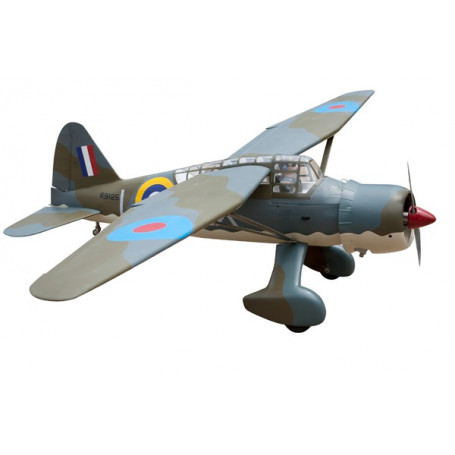
As I was representing the Special Duties variant of the Mk III I also needed to add the underslung long range fuel tank, and the rear cockpit access ladder to the Port side. These and the previously mentioned missing parts were modelled in 3D CAD and either 3D printed, laser cut, or scratch built.
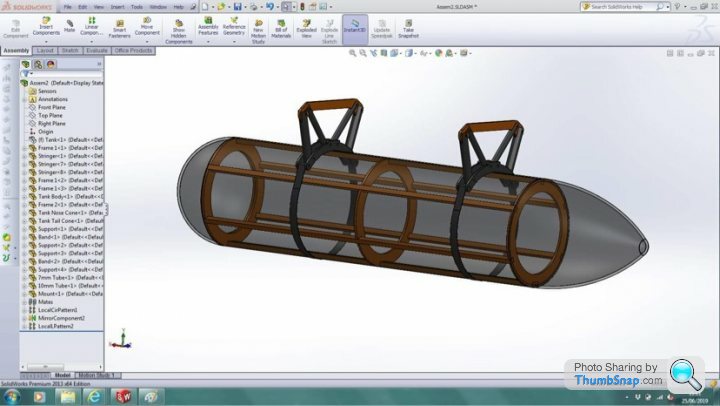
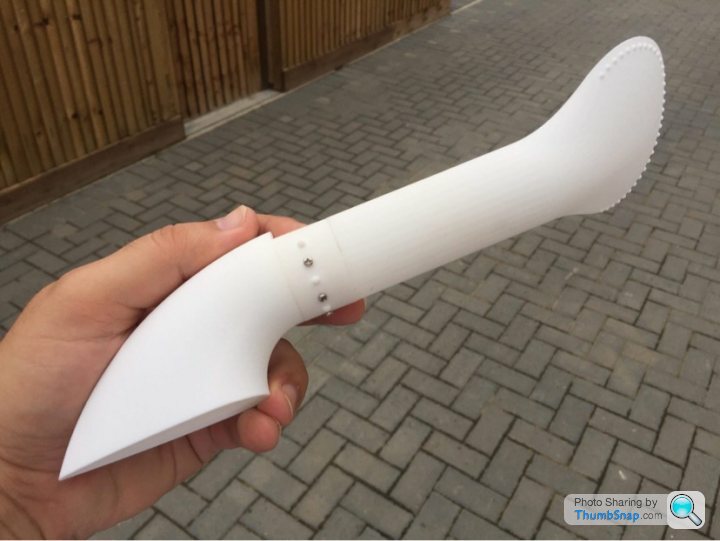
I also modelled 6 dummy cylinder heads to fit between the 3 real ones inside the cowl so that it gave the impression of a full 9-cylinder Bristol Mercury. These are yet to be fitted.

The cowl was cut just forward of the heat vents/flaps and had about 50mm of the cylindrical element removed, before the vents were glassed back on to give a more realistic look. 3D printed blisters were added, and rivet detail was created by applying dobs of PVA using a pin head.
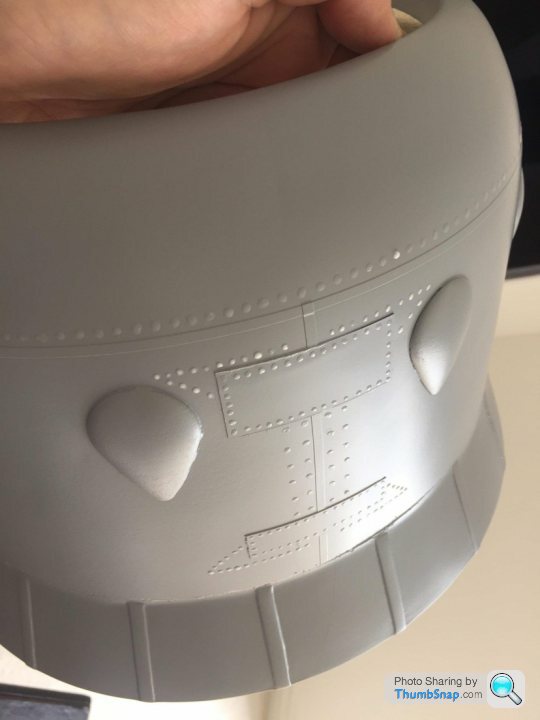
All of the factory installed covering was removed and replaced with a pre-painted black iron-on fabric called Oratex. This instantly uplifted the visual quality of the model. While the skin was off I added some aluminium curtain rail to act as runners for the rear canopy. This turned the otherwise fixed glazing into an additional access point for interior workings and detail. It also allows the model to be posed in different scenarios.
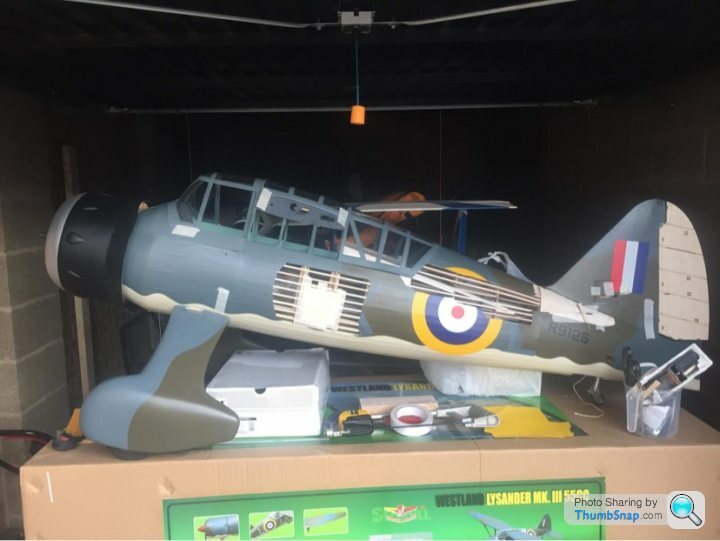
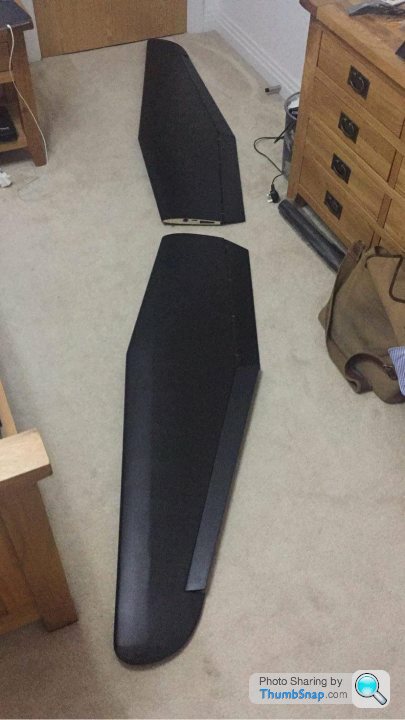
The dummy long range fuel tank was made from some laser cut liteply frames joined with balsa stringers and skinned in 0.2mm pre-cured fibreglass sheet. The round nose is an acrylic half sphere sourced from eBay, and the tail cone was fashioned from styrafoam and then skinned with filler. Again, PVA rivets were added with a pin head.
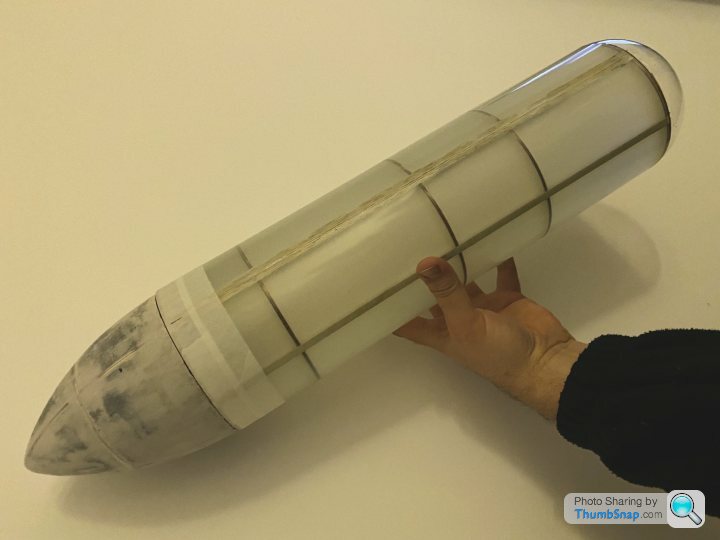
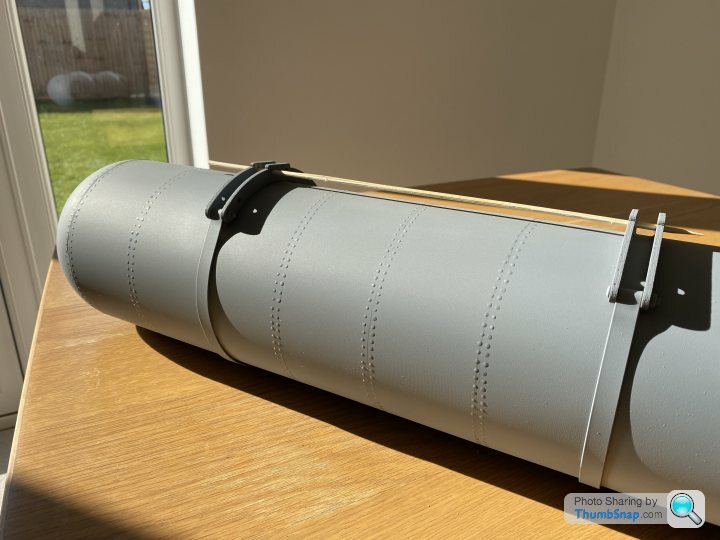
The ladder was made using Plastistruct PVC pipe. Heated and gently, and progressively bent around a wood pattern to gain 2 similar uprights.
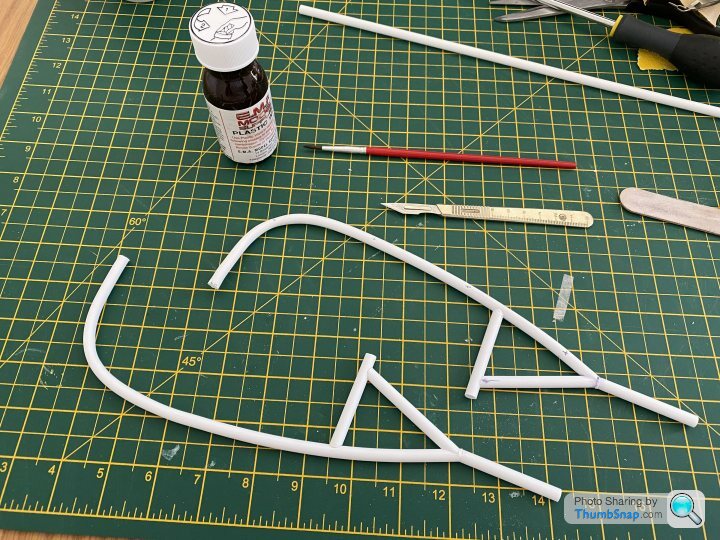
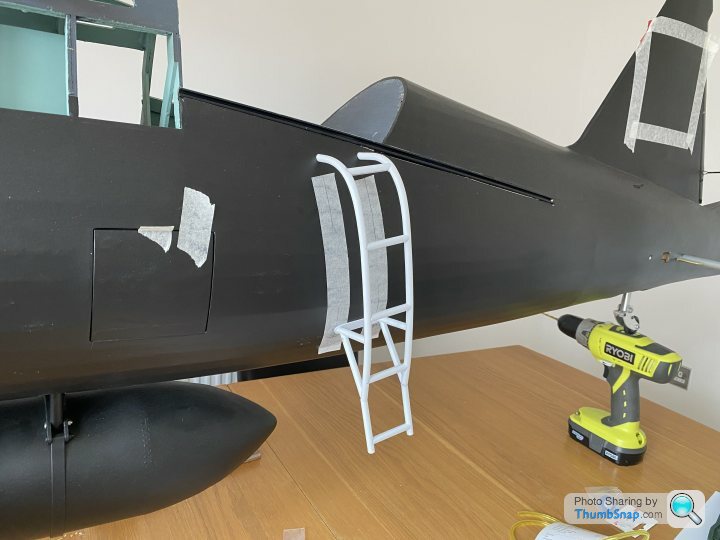
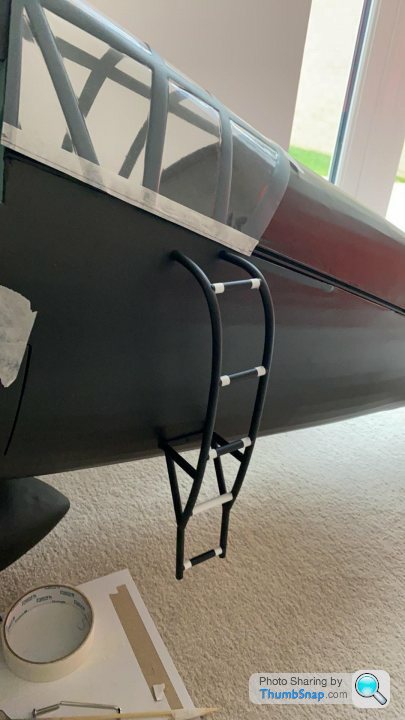
Jim himself is a 3D printed model that I painted using Tamiya acrylics. I am quite happy with how he turned out.
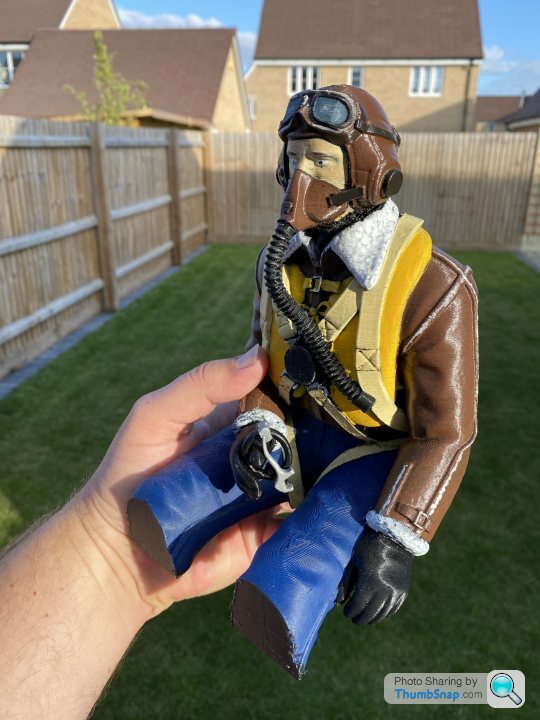
The dashboard was built using a ‘bashed’ 1:5 Spitfire cockpit kit. I had to make a new outer panel to better represent the Lysander, but the floating centre dials are the same layout.

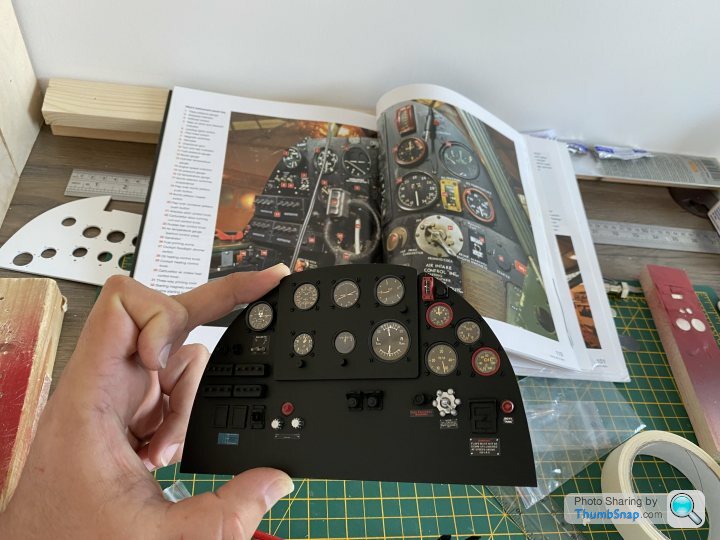
You can buy landing light kits for RC planes, but almost all of them feature cold white LEDs, which would simply look wrong. I found some 12v warm white domestic LED’s that looked like lamp units on eBay. Holes were cut in the wheel spats and mounting plates for the bulbs were glued inside. The lenses were fashioned from the necks of clear 2L soft drinks bottles. This gave a pre-formed double curvature bubble that nicely matched the outer face of the spats. Black models have a nasty habit of silhouetting in the sky, so the lights will be switched on for the duration of flights to aid with orientation.
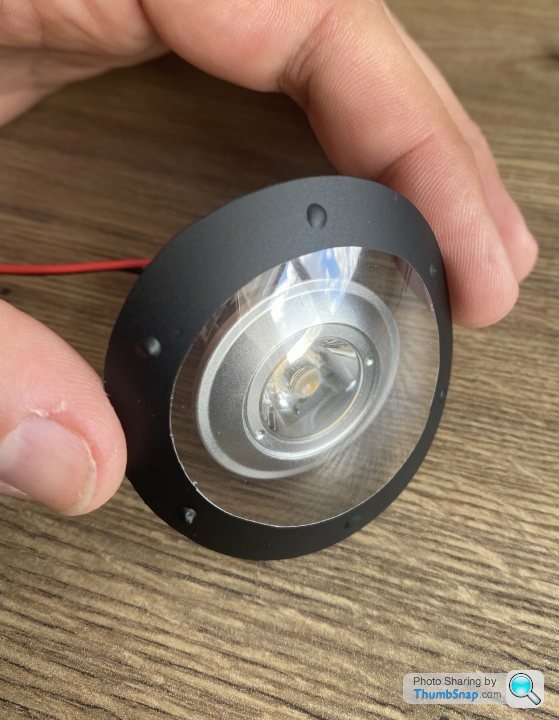
There are still some details to finish off, namely the remainder of the markings. Incidentally I can’t find any evidence that MA-E ever wore the all-over black scheme. There are stories that the black was too obvious on the moonlit nights that 161 flew. All photos show it with black lowers and grey/green upper surfaces which was more widely adopted. The black scheme has become somewhat iconic thanks to The Shuttleworth Collection, and it does look smart. For now, it’ll remain all-black, but I might one day add the grey/green to the topside.
So, after all of that I'm left with a reasonable facsimile of the real thing. And, yes, I will risk it and the model will be flown.

Why a Lysander?
Well, I like unusual models. I find that people tend to gravitate towards the same models and so club flying days seem to be populated by lots of the same aircraft types; Spitfires and F-16’s being particular favourites it would seem. That being said, there are now 3 of these Lysanders owned/flown by members of my club! Anyway, there were none when I ordered the kit and that was part of my decision. Also, I like to model aircraft that have some sort of relevance. I live just a couple of miles from The Shuttleworth Collection at Old Warden, which amongst its aircraft is a Lysander that has for many years flown in the guise of an all-black Lysander of 161 (Special Duties) Squadron. That unit was itself based locally in period. What was RAF Tempsford, some 6 miles or so to the north.
By way of a quick outline of the aircraft’s history; the Lysander was conceived in the 1930’s as an Army Co-operation aircraft, mainly to act as an artillery spotting platform. To that end it was designed to land in small, un-prepared fields, close to the artillery guns so that written messages could quickly be handed over. However, this concept had been drawn up on the basis that the next war would be fought similarly to the entrenched scenarios witnessed in WW1. During the Battle of France it was quickly realised that technology had moved on a pace and that the Lysander in that role was now obsolete. But it’s short field landing and take off ability, and the space to carry passengers in the rear cockpit (previously a rear gunner/spotter provision) made it ideal for the Special Operations Executive (SOE) to use to send and retrieve agents from occupied France. Adopted by 161 (SD) Sqn, painted black, and operating on full moon nights, they became known as ‘Tempsford Taxis’.
I am by no means the first person to finish one of these models in 161 Sqn markings. One of the other models in my club was converted by it’s previous owner. Those that are often adopt the identity worn by the Shuttleworth aircraft; MA-B and indeed the club stablemate is just that. Mine will wear MA-E, an aircraft which was regularly flown by F/O James Atteby ‘Jim’ McCairns, a pilot with a quite remarkable history.
He joined the RAF as a Sergeant Pilot, and was posted to 616 Sqn flying Spitfires under the command of Douglas Bader. On one sortie he crash landed on a beach near Dunkirk, and was taken as a prisoner of war. Having escaped from Germany, he was picked up by the Belgian resistance who harboured him from the Nazis. He managed to be repatriated to the UK, but only after travelling across occupied western Europe to Gibraltar! Upon returning to the UK he was promoted to Flight Sergeant, and embarked on a tour of RAF stations delivering lectures on how to survive behind enemy lines and escape tactics. He then joined 161 (SD) Sqn. Where he was Commissioned as an Officer. He flew 34 Lysander missions, of which 25 were successful, making him the most effective Lysander SOE pilot. He was promoted to Flight Lieutenant and after a short stint as a Staff Officer he returned to flying Spitfires, Tempests, and Mosquitos. Unfortunately while on a low level training sortie in the latter he suffered an engine failure. The aircraft stalled a wing, rolled over and crashed in flames near RAF Finningley, killing Jim. He was 28.
A truly remarkable young man. A more in-depth account of his life can be found here:
https://en.wikipedia.org/wiki/Jim_McCairns
The Model
I used an Almost Ready To Fly (ARTF) kit made by a company called Seagull as the starting point. This is a type of model that is referred to as ‘Sports Scale’, meaning that it is representative of the real thing, but not a true scale model. Its wingspan is 117” which equates to about 3 meters and is designed to be powered by a 50 to 60cc petrol engine, or electric equivalent. Part of my gripe with RC models is that they often don’t sound right (turbine powered jets excepted). I often see beautifully detailed large scale Spitfires that look wonderful, but they’re hauled around the sky by single cylinder 2-strokers. It somewhat spoils the illusion. There are though some very sweet 4-stroke engines available, and in particular the radials do sound good, especially at idle. This was another driver for choosing this model as it pairs up nicely with the Saito 60cc 3 cylinder 4-Stroke radial. In fact it shouldn’t even require full throttle to potter around at something like scale speed.
Out of the box the model is quite crude. The pre-installed covering is smooth, plasticky, and somewhat shiny, not to mention inaccurate in colour for the aircraft that it represents (ironically another locally based airworthy Lizzie at Duxford). The pilot supplied is too big and wearing a red baseball cap (Trump?). The representation of the cockpit dashboard had what looked like a glass screen chart plotter! The fibreglass engine cowl is way too long. And signature Lysander details, such as the exhaust pipe and landing light lenses on the wheel spats/pants are omitted.
The standard model:

As I was representing the Special Duties variant of the Mk III I also needed to add the underslung long range fuel tank, and the rear cockpit access ladder to the Port side. These and the previously mentioned missing parts were modelled in 3D CAD and either 3D printed, laser cut, or scratch built.


I also modelled 6 dummy cylinder heads to fit between the 3 real ones inside the cowl so that it gave the impression of a full 9-cylinder Bristol Mercury. These are yet to be fitted.

The cowl was cut just forward of the heat vents/flaps and had about 50mm of the cylindrical element removed, before the vents were glassed back on to give a more realistic look. 3D printed blisters were added, and rivet detail was created by applying dobs of PVA using a pin head.

All of the factory installed covering was removed and replaced with a pre-painted black iron-on fabric called Oratex. This instantly uplifted the visual quality of the model. While the skin was off I added some aluminium curtain rail to act as runners for the rear canopy. This turned the otherwise fixed glazing into an additional access point for interior workings and detail. It also allows the model to be posed in different scenarios.


The dummy long range fuel tank was made from some laser cut liteply frames joined with balsa stringers and skinned in 0.2mm pre-cured fibreglass sheet. The round nose is an acrylic half sphere sourced from eBay, and the tail cone was fashioned from styrafoam and then skinned with filler. Again, PVA rivets were added with a pin head.


The ladder was made using Plastistruct PVC pipe. Heated and gently, and progressively bent around a wood pattern to gain 2 similar uprights.



Jim himself is a 3D printed model that I painted using Tamiya acrylics. I am quite happy with how he turned out.

The dashboard was built using a ‘bashed’ 1:5 Spitfire cockpit kit. I had to make a new outer panel to better represent the Lysander, but the floating centre dials are the same layout.


You can buy landing light kits for RC planes, but almost all of them feature cold white LEDs, which would simply look wrong. I found some 12v warm white domestic LED’s that looked like lamp units on eBay. Holes were cut in the wheel spats and mounting plates for the bulbs were glued inside. The lenses were fashioned from the necks of clear 2L soft drinks bottles. This gave a pre-formed double curvature bubble that nicely matched the outer face of the spats. Black models have a nasty habit of silhouetting in the sky, so the lights will be switched on for the duration of flights to aid with orientation.

There are still some details to finish off, namely the remainder of the markings. Incidentally I can’t find any evidence that MA-E ever wore the all-over black scheme. There are stories that the black was too obvious on the moonlit nights that 161 flew. All photos show it with black lowers and grey/green upper surfaces which was more widely adopted. The black scheme has become somewhat iconic thanks to The Shuttleworth Collection, and it does look smart. For now, it’ll remain all-black, but I might one day add the grey/green to the topside.
So, after all of that I'm left with a reasonable facsimile of the real thing. And, yes, I will risk it and the model will be flown.

Edited by Boatbuoy on Friday 4th December 12:24
Great project! The Lysander is a favourite of mine from childhood, having built plastic models of it. I recently build a 1:48 version too. It was an ungainly looking aircraft even when introduced, but actually had a very sophisticated wing, with a system of automatic, mechanically linked slats and flaps. I was lucky enough to get a guided tour of the Shuttleworth aircraft a couple of years ago at Duxford. does your model replicate the high lift systems on the wing?
dr_gn said:
Great project! The Lysander is a favourite of mine from childhood, having built plastic models of it. I recently build a 1:48 version too. It was an ungainly looking aircraft even when introduced, but actually had a very sophisticated wing, with a system of automatic, mechanically linked slats and flaps. I was lucky enough to get a guided tour of the Shuttleworth aircraft a couple of years ago at Duxford. does your model replicate the high lift systems on the wing?
It is somewhat odd looking, but that's the attraction. 'Teddy' Petter who designed it was certainly an out of the box thinker, and he of course went on to design the EE Canberra, another favourite, and indeed subject I've modelled in RC.The wing on this model is far more conventional than the real thing. No slats, but it does have flaps, albeit they are commanded rather than auto. The real Lizzies also have a configurable horizontal stabiliser that allows that auto system to be effective. Again, the model is simplified and features a fixed tailplane. In theory It was all good stuff, but many pilots were caught out by these unusual systems. It can be counter intuitive on the real thing, especially during the landing phase. As you reduce speed the slats & flaps deploy, slowing you down. There's a natural tendency to apply power to counter that but as speed builds the lift devices retreat and lift is lost!
Lukily I've got plenty of airfield to play with and will operate the model in a more conventional manner.
P5BNij said:
Fabuous - how much does it weigh and where the hell do you keep it...?
Fond memories of the large-ish scale Matchbox Lysander I built about forty years ago, finished in matt black!
Thank you. It tips the scales at about 9kgs. It breaks down into component parts quite well. The fuselage is suspended from the garage ceiling, and the wings sit on a shelf.Fond memories of the large-ish scale Matchbox Lysander I built about forty years ago, finished in matt black!
Boatbuoy said:
By way of a quick outline of the aircraft’s history; the Lysander was conceived in the 1930’s as an Army Co-operation aircraft, mainly to act as an artillery spotting platform. To that end it was designed to land in small, un-prepared fields, close to the artillery guns so that written messages could quickly be handed over. However, this concept had been drawn up on the basis that the next war would be fought similarly to the entrenched scenarios witnessed in WW1. During the Battle of France it was quickly realised that technology had moved on a pace and that the Lysander in that role was now obsolete.
Is this really true? I'm pretty sure they were using radios for aerial artillery spotting in WW1.Lovely model, excellent bit of detailing you've done.
The flying notes by one of the shuttleworth pilots make interesting reading.
Edited by hidetheelephants on Sunday 13th December 19:40
hidetheelephants said:
<snip>
The flying notes by one of the shuttleworth pilots make interesting reading.
Some fine understatement in the notes The flying notes by one of the shuttleworth pilots make interesting reading.
Edited by hidetheelephants on Sunday 13th December 19:40

When one flies (not me, except as a passenger of course my flying begins and ends with Biggles & non-fiction!) many aircraft and only occasionally something like this how the dickens does one suspend unconscious competences in practice on more regular steeds? Especially in emergency conditions.
jet_noise said:
Some fine understatement in the notes 
When one flies (not me, except as a passenger of course my flying begins and ends with Biggles & non-fiction!) many aircraft and only occasionally something like this how the dickens does one suspend unconscious competences in practice on more regular steeds? Especially in emergency conditions.
"There are old pilots and there are bold pilots, but there are no old, bold pilots."
When one flies (not me, except as a passenger of course my flying begins and ends with Biggles & non-fiction!) many aircraft and only occasionally something like this how the dickens does one suspend unconscious competences in practice on more regular steeds? Especially in emergency conditions.
Hi All,
Apologies for the delay in supplying any updates. The model went into storage for a while due to other projects taking priority. Over the last few weeks I've found a renewed interest and pushed to get it finished. It took it's maiden flight 2 weeks ago which was mostly successful. I ran out of up elevator trim so most of the flight was conducted on half flap. Speed was maintained to avoid any tip stall, although I'm confident that a slower, more scale speed can be achieved once the model is fully set up and correctly trimmed. Unfortunately 2 of the 3 sparkplug caps had been playing up, and on landing - which was quite fast - I bounced. 2 cylinders stopped firing, and the engine stopped developing enough power to pull away. With airspeed plummeting a hard landing ensued, resulting in some damage to one undercarriage leg.
On the plus side it looked and sounded fantastic in the air. Repairs are well underway, the engine issue has been resolved. and it will be taking to the air again in the next few weeks. Link to a video below, but I'll get better footage night time.
Apologies for the delay in supplying any updates. The model went into storage for a while due to other projects taking priority. Over the last few weeks I've found a renewed interest and pushed to get it finished. It took it's maiden flight 2 weeks ago which was mostly successful. I ran out of up elevator trim so most of the flight was conducted on half flap. Speed was maintained to avoid any tip stall, although I'm confident that a slower, more scale speed can be achieved once the model is fully set up and correctly trimmed. Unfortunately 2 of the 3 sparkplug caps had been playing up, and on landing - which was quite fast - I bounced. 2 cylinders stopped firing, and the engine stopped developing enough power to pull away. With airspeed plummeting a hard landing ensued, resulting in some damage to one undercarriage leg.
On the plus side it looked and sounded fantastic in the air. Repairs are well underway, the engine issue has been resolved. and it will be taking to the air again in the next few weeks. Link to a video below, but I'll get better footage night time.
Gassing Station | Scale Models | Top of Page | What's New | My Stuff




